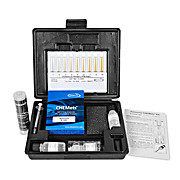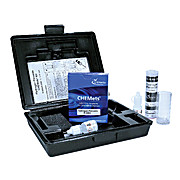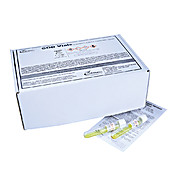CHEMetrics
-
Dissolved Oxygen SAM Kit
CHEMetricsRange: 0-15.0 ppm Method: Indigo Carmine SAM Kit comes in a plastic case and contains everything needed to perform 30 tests: Vacu-vials Kit, SAM Photometer, 4AAA batteries, screwdriver, light shield and instructions.
-
Hydrogen peroxide is a strong oxidizing agent with a variety of uses. Applications include the treating of industrial effluents and domestic waste and serving as a disinfectant in aseptic packaging. For the food and beverage industry, CHEMetrics Hydrogen Peroxide CHEMets® and…
-
Low-level ammonia nitrogen may be naturally present in water as a result of the biological decay of plant and animal matter. Higher concentrations in surface waters can indicate contamination from waste treatment facilities, raw sewage, industrial effluents (particularly from petroleum refineries),…
-
Hydrogen peroxide is a strong oxidizing agent with a variety of uses. Applications include the treating of industrial effluents and domestic waste and serving as a disinfectant in aseptic packaging. For the food and beverage industry, CHEMetrics Hydrogen Peroxide CHEMets® and…
-
Silica CHEMets® Kits
CHEMetricsSilica (SiO2) is the oxide of silicon, the second most abundant element in the earth's crust. Silica is present as silicates in most natural waters. Typical concentrations lie between 1 and 30 mg/L. Higher concentrations may exist in brackish waters and brines. The silica content of…
-
Iron is present in nature in the form of its oxides, or in combination with silicon or sulfur. The soluble iron content of surface waters rarely exceeds 1 mg/L, while ground waters often contain higher concentrations. The National Secondary Drinking Water Standard for iron is 0.3 mg/L, as iron…
-
Zinc Vacu-vials Kit 0-15.00 ppm
CHEMetricsWARNING! This product can expose you to chemicals including ethylene glycol, which is known to the State of California to cause birth defects or other reproductive harm. For more information go to www.P65Warnings.ca.gov . Shelf life = 8 months
-
Hardness is a measure of the mineral content of water. Calcium and magnesium are the most common minerals that contribute to hardness. Hard water causes scaling in boilers and other industrial equipment, and diminishes the effectiveness of soaps and detergents. The EDTA Method (Total) …
-
Phosphate Vacu-vials® Kits
CHEMetricsPhosphorus occurs naturally in rock formations in the earth's crust, usually as phosphate. High phosphate concentrations in surface waters may indicate fertilizer runoff, domestic waste discharge, or the presence of industrial effluents or detergents. Although phosphates from these sources are…
-
Chlorine Comparator
CHEMetricsThe CHEMetrics chlorine comparator is an ideal thing to have in any chemical laboratories, medicinal facilities or healthcare units for a wide range of purposes such as scientific research and development.
-
Glycol CHEMets Kit
CHEMetricsEthylene glycol and propylene glycol are the primary ingredients in commercially-available antifreezes. They are used with various corrosion inhibitors to protect metal surfaces in cooling water systems. CHEMetrics glycol kits are used to monitor potable waters for glycol contamination…
-
 Phenols CHEMets® Kits
CHEMetrics
Phenols CHEMets® Kits
CHEMetricsPhenol (hydroxybenzene) is the simplest of a group of similar organic chemicals, which includes cresols, xylenols, and catechols. Phenol itself is a common ingredient of disinfectants. In drinking water, low-level phenolic concentrations impart a foul taste and odor, especially upon chlorination.…
-
Method Dissolved carbon dioxide (CO2) is naturally present as a result of animal respiration, the decay of organic matter, and the decomposition of certain minerals. It is the major source of acidity in unpolluted water samples. Surface waters typically contain less than 10 ppm…
-
Alkalinity Titrets® Kits
CHEMetricsMethods The alkalinity of water is a measurement of its buffering capacity. Alkalinity of natural waters is typically a combination of bicarbonate, carbonate, and hydroxide ions. Sewage and wastewaters usually exhibit higher alkalinities due to the presence of silicates and phosphates. …
-
Phosphate Comparator
CHEMetricsThe CHEMetrics phosphate comparator with a range of 0 to 1200 ppm is an ideal thing to have in any chemical laboratories, medicinal facilities or healthcare units for a wide range of purposes such as scientific research and development.
-
Persulfate CHEMets Kit
CHEMetricsPersulfate is a strong oxidizer that is commonly used for clarifying swimming pools and spas and for the destruction of a broad range of soil and groundwater contaminants. Sodium persulfate is frequently used for environmental applications. The Ferric Thiocyanate Method Reference: D.F.…
-
Phenols VACUettes® Kits
CHEMetricsPhenol (hydroxybenzene) is the simplest of a group of similar organic chemicals, which includes cresols, xylenols, and catechols. Phenol itself is a common ingredient of disinfectants. In drinking water, low-level phenolic concentrations impart a foul taste and odor, especially upon chlorination.…
-
Sulfide Vacu-vials® Kits
CHEMetricsSulfides are naturally present in ground waters as a result of leaching from sulfur-containing mineral deposits. Surface waters do not usually contain high sulfide concentrations. Sulfides result from the decomposition of organic matter, from bacterial sulfate reduction under anaerobic conditions…
-
Sulfide Comparator
CHEMetricsThe CHEMetrics sulfide comparator is a suitable thing to have in any chemical laboratories, medicinal facilities or healthcare units for a wide range of applications such as scientific research and development.
-
Sulfide Comparator
CHEMetricsThe CHEMetrics sulfide comparator is a perfect thing to have in any chemical laboratories, medicinal facilities or healthcare units for a wide range of applications such as scientific research and development.
-
Kit comes in a plastic case and contains everything needed to perform 30 tests (except distilled water): Refill, Low and High Range Comparators, dilutor snapper cup, micro test tube, and instructions. Range: 0-120 & 120-1200 ppm MDL: 20 ppm Method: Direct Nesslerization …
-
Chromate (Hexavalent) Vacu-vials Kit
CHEMetricsHexavalent chromium salts are used in numerous industrial processes. They are also used extensively as corrosion inhibitors in open and closed cooling water systems. The Diphenylcarbazide Method References: APHA Standard Methods, 23rd ed., Method 3500-Cr B - 2009. ASTM D 1687-02,…
-
COD VIALS MERC FREE 98VIALS UN 1830
CHEMetricsKit comes in a cardboard box and contains everything needed to perform up to 97 tests (except distilled water): 98 vials and instruction book. Range: 0-15,000 ppm (HR+) Mercury Free Method: APHA Standard Methods, 23rd ed., Method 3500-Cu C-1999. All COD Kits require the use…
-
Iron CHEMets Kit
CHEMetricsIron is present in nature in the form of its oxides, or in combination with silicon or sulfur. The soluble iron content of surface waters rarely exceeds 1 mg/L, while ground waters often contain higher concentrations. The National Secondary Drinking Water Standard for iron is 0.3 mg/L, as iron…
-
Chromate (Hexavalent) CHEMets Kit
CHEMetricsHexavalent chromium salts are used in numerous industrial processes. They are also used extensively as corrosion inhibitors in open and closed cooling water systems. The Diphenylcarbazide Method References: APHA Standard Methods, 22nd ed., Method 3500-Cr B - 2009. ASTM D 1687-02,…
-
Ammonia HBA Test Kit
CHEMetricsLow-level ammonia nitrogen may be naturally present in water as a result of the biological decay of plant and animal matter. Higher concentrations in surface waters can indicate contamination from waste treatment facilities, raw sewage, industrial effluents (particularly from petroleum refineries),…
-
Hydrogen Peroxide SAM Kit
CHEMetricsHydrogen peroxide is a strong oxidizing agent with a variety of uses. Applications include the treating of industrial effluents and domestic waste and serving as a disinfectant in aseptic packaging. The Ferric Thiocyanate Method Reference: D. F. Boltz and J. A. Howell, eds.,…
-
Peracetic Acid SAM Kit
CHEMetricsRange: 0-5.0 ppm Method: DPD SAM Kit comes in a plastic case and contains everything needed to perform 30 tests: K-7913 Vacu-vials Kit, SAM Photometer, light shield, 4AAA batteries, screwdriver, and instructions.
-
Nitrite CHEMets Kit, Range: 0-2.5 ppm
CHEMetricsNitrite, an intermediate in the nitrogen cycle, is formed during the decomposition of organic matter but readily oxidizes to form nitrate. These processes occur in wastewater treatment plants, water distribution systems, and natural waters. Nitrites are useful as corrosion inhibitors,…
-
Because of its strong oxidizing properties, chlorine is an excellent biocide used to treat potable waters, municipal wastes, and swimming pools. When used to treat potable water, chlorine helps alleviate the adverse effects of iron, manganese, ammonia, and sulfide. The Maximum Residual Disinfectant…
-
Formaldehyde CHEMets Kit
CHEMetricsFormaldehyde, a toxic substance, is used in the following applications: metal plating baths, textile treatments, biological specimen preservatives, and disinfectants of medical equipment. Commercial formaldehyde gas is readily soluble in water. The Purpald Method Reference:…
-
 COD Analysis Kits
CHEMetrics
COD Analysis Kits
CHEMetricsUSEPA-approved Mercury-free COD kits CHEMetrics’ leakproof reagent vials contain premeasured solutions of sulfuric acids and potassium dichromate. To perform the COD determination, the analyst simply removes the Teflon® lined screw cap from the vial, adds sample to the vial,…


































